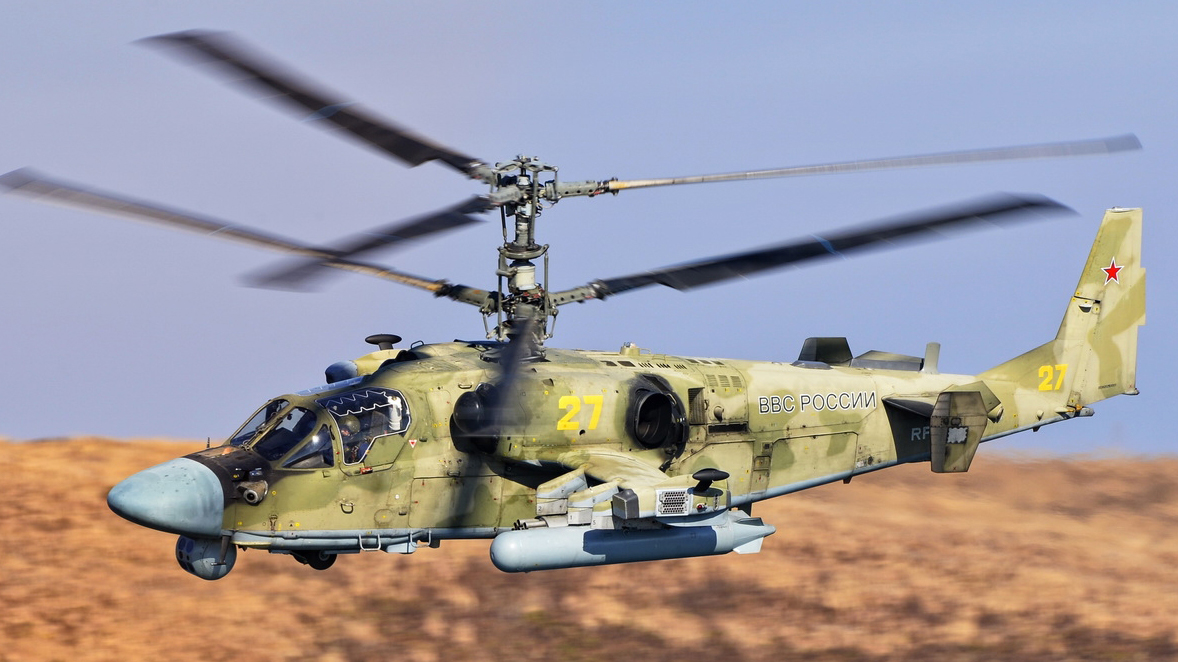It’s fair to say that the Ka-52 Hokum attack helicopter has become something of a signature weapon on the Russian side in the conflict in Ukraine. Reflecting the mixed results of the Kremlin’s war more generally, the Ka-52 has sustained heavy losses, shown some apparently problematic flying characteristics when heavily loaded with weapons, and performed some very ill-advised stunts. Meanwhile, it has also borne the brunt of the close air support missions now being flown in an effort to blunt the Ukrainian counteroffensive. And for one Ka-52 crew, the helicopter’s unique configuration very likely saved their lives during one, apparently recent mission.
A video that began to circulate on social media today shows a Ka-52 flying at a relatively low level, with its tail torn apart, the remnants of the vertical fin dangling precariously from the rear. A photo of the helicopter after landing reveals how that part of the empennage was twisted around to more than 90 degrees but somehow remained attached.
The video seems to have been shot from the cockpit of the Ka-52’s wingman, or another accompanying helicopter. While we can’t be sure where the video was taken, or when, it seems almost certain it was in southeastern Ukraine, with what looks like part of the Black Sea coastline visible at the start.
As well as the wrecked tail, several items can be seen falling away from the Ka-52 right at the start of the video, apparently stores jettisoned by the crew, but they could potentially also be other parts of the tail assembly that fell away.
There have been claims that the crew’s jettisoning of external stores — in particular, the fuel tanks — is what led to the tail damage in the first place, with one of these tanks said to have been thrown back up into the slipstream and impacted the tail. It’s not possible to tell, looking at this video, whether that’s the case, although the fact that four items are apparently jettisoned suggests that drop tanks (carried in pairs) and rocket pods were discarded. That could also suggest that the issue with the tail emerged before the decision was taken to jettison stores.
However, poor separation of stores is certainly an issue that can lead to potentially very hazardous impacts on an aircraft.
The front end of the helicopter seems to have been damaged, too, with a suggestion that the windshield was torn off, or at least some part of the forward fuselage also appears to be missing.
All in all, it seems just as likely that the Ka-52 fell victim to Ukrainian air defenses, which managed to get a hit on the airframe, although without causing enough damage to knock it out of the sky.
Whatever the case, the two-man crew of the attack helicopter has reason to be grateful for the design of their aircraft. One of the key features of the Ka-52 is its unconventional coaxial main rotor arrangement, obviating the need for a tail rotor.

In almost any other helicopter, this level of damage to the tail assembly would be an extremely serious event.
In a conventional helicopter, the tail rotor is mounted at the end of the tail boom. Since the tail rotor provides torque to counteract the main rotors (which are rotating either clockwise or counterclockwise), if it stops functioning, the helicopter will begin spinning in the opposite direction of the main rotor. In the best-case scenario, the pilot will then enter an autorotation and perform an emergency running landing. In the worst case, it will lead to a crash or even a mid-air breakup. The lower and slower a helicopter is flying when it loses its tail rotor, the less likely it is that the pilot will be able to recover at all.

With that in mind, a coaxial main rotor — in which there are two sets of main rotors, one above the other, one turning clockwise and one counterclockwise — makes a good deal of sense for an attack helicopter, which will likely spend much of its time low and slow. But there are also major tradeoffs to this configuration.
While coaxial main rotors are a trademark of the Kamov design bureau’s naval helicopter designs, they also retained them for the (primarily) land-based Ka-50/52 series. These helicopters also have other unusual survivability features, including a crew rescue system.

Often described as being fitted with ejection seats, the Ka-52 actually doesn’t have true ejection seats, but instead, a crew extraction system, which doesn’t rely on rockets to punch the seats out of the cockpit, but instead to drag them out.
In the Ka-52, the crew extraction system first jettisons the main rotor blades using a series of explosive bolts. The cockpit canopy glass is then jettisoned, and two rocket assemblies are launched out of the cockpit. Each rocket assembly is connected via a lanyard to one of the Zvezda/Tomilino K-37-800M seats, which is then pulled out of the cockpit before a parachute is deployed. The system can be operated at speeds from zero to 189 knots, and also at zero altitude.
So far, we have seen surprisingly few conclusive examples of Ka-52 crew using the crew extraction system during the war in Ukraine, although the number of losses suggests that it has likely been used on various other undocumented occasions, successfully or otherwise.

As it is, we don’t know for sure why a Ka-52 was left flying over Ukraine with its tail assembly shredded, although we can say with some certainty that, had they been flying another helicopter type, the crew in question are far less likely to have made it back to their base.
Contact the author: thomas@thedrive.com
